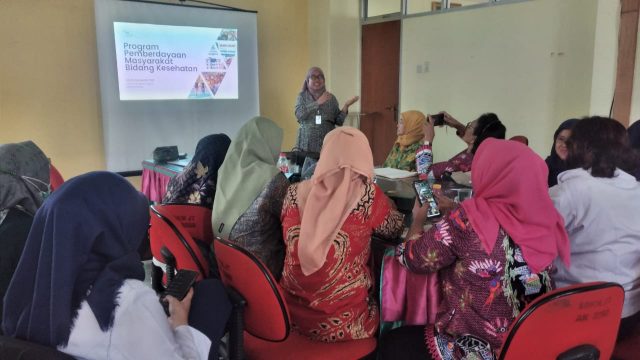Miss Lily El Ferawati, a lecturer of the Communications program, at BINUS University International was invited to deliver a speech at a program held by the Health Department of East Jakarta Administrative City called “Monitoring dan Evaluasi Program Pemberdayaan Masyarakat Bidang Kesehatan” (Monitoring and Evaluation of Community Empowerment in Health).

The event took place on July 24th, 2024 from 12.00 to 15.00, involving 20 representatives of the Public Health Centers and PKK (Pemberdayaan Kesejahteraan Keluarga) from 5 sub-districts in the administrative city. Each representative of the Public Health Centre presented the report of Community Empowerment programs they handled within the second quarter of 2024.
Miss Lily served as an assessor by which she provided comments on the report presented by each representative. After the report presentation, Miss Lily delivered her speech to explain the evaluation and the strategies for innovative community empowerment programs.
By definition, community empowerment in health refers to “a fundamental idea in health promotion that can help communities determine priorities, make choices, develop strategies and implement them to improve health and minimize health disparities” (Kruahong et al., 2023).
Community empowerment in health revolves around four main pillars as listed below.
The reports presented by the health representatives showed that the community empowerment programs in East Jakarta are dominantly centered around providing fundamental health services through Posyandu (Pos Pelayanan Kesahatan Terpadu/Integrated Health Service Posts) and its subsidiaries including Posyandu Lansia (Posyandu for aging community members), Posyandu Remaja (Posyandu for teenagers), and Posyandu KIA (Posyandu for Mother and Kids), as well as Posbindu (Pos Binaan Terpadu/Integrated Health Monitoring Posts).
To ensure its success, community empowerment programs must achieve five principles. According to Kusbaryanto, the five principles are as follows:
The community empowerment programs in East Jakarta as reported by the health representatives showed that the programs heavily rely on the Puskesmas or Pusat Kesehatan Masayarakat (Public Health Centre) as the main provider of health services and empowerment. It indicates that the community empowerment programs lack decentralization and community cooperation.
Based on the challenges reported by the health representatives, it is recommended to have some strategies for community empowerment programs in health. Basically, before developing a community empowerment program, some strategies are needed including
Some innovative ideas that can be implemented include
Conducting community empowerment programs in health indeed is challenging especially when community members have little knowledge and consciousness about personal health. The role of Puskesmas will continue dominant but it is possible to promote larger community participation and volunteerism through continuous health communication and social partnership involving education institutions, private entities, and health providers.
References
Kruahong, S., Tankumpuan, T., Kelly, K., Davidson, P. M., & Kuntajak, P. (2023). Community empowerment: A concept analysis. Journal of advanced nursing, 79(8), 2845-2859.
Kusbaryanto (n.d.) Pemberdayaan Masyarakat di Sektor Kesehatan. Accessed on 22 July 2024 from https://myklass-fkik.umy.ac.id/pluginfile.php/55949/mod_resource/content/1/PEMBERDAYAAN%20MASYARAKAT%20DI%20SEKTOR%20KESEHATAN%20-%20dr.%20kusbaryanto.pdf
Advocacy and Communication Solutions. (2020). 12 Tips for Community Engagement. Accessed on 22 July 2024 from https://www.advocacyandcommunication.org/wp-content/uploads/2020/05/ACS_Community_Engagement_Tips.pdf
Contributor: Lily El Ferawati
... ... ...